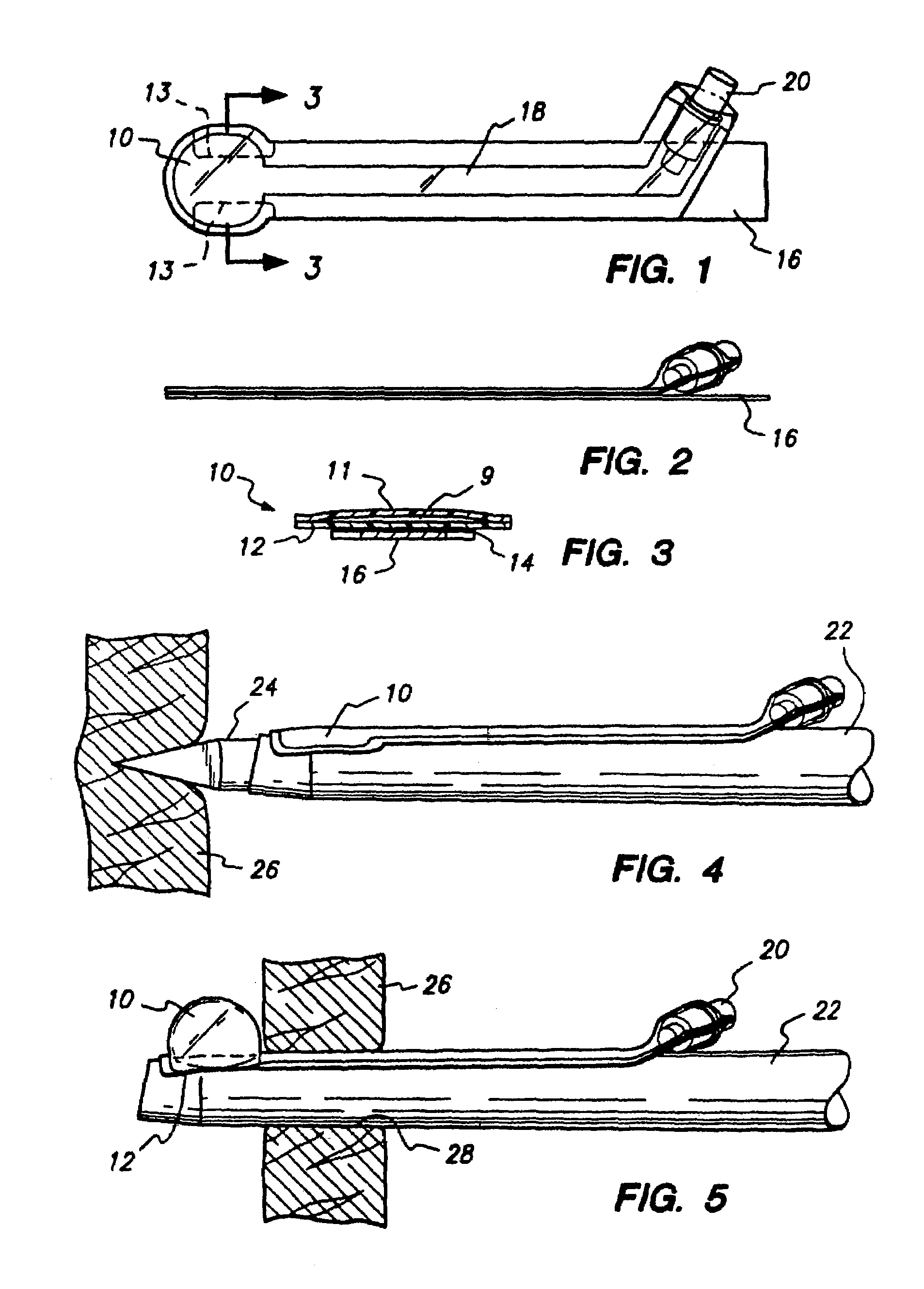Method and apparatus for anchoring laparoscopic instruments
a technology for laparoscopic instruments and anchoring devices, applied in the field of improved anchors, can solve the problems of requiring insertion of screw threads, requiring relatively traumatic twisting, and expensive fabrication of cannulas, and achieves the effect of low profile, facilitating low insertion force placement and removal
- Summary
- Abstract
- Description
- Claims
- Application Information
AI Technical Summary
Benefits of technology
Problems solved by technology
Method used
Image
Examples
first embodiment
[0064]As shown in FIGS. 1–3, this embodiment comprises an elastomeric balloon 10 having a first film layer 11 of elastic or semi-elastic material, and a second film layer 12 of elastic, semi-elastic or inelastic material. Second film layer 12 is ideally very flexible so that it can easily confirm to the outside surface of an instrument such as a trocar sheath. Preferably, first film layer 11 and second film layer 12 are made of material suitable for medical applications having a good strength to thickness ratio. Thinner materials facilitate lower deflated profiles and thus lower incision insertion forces. First film layer 11 can be made of urethane or other appropriate film. A semi-elastic PS-8010 polyurethane film, referred to as PS-8010, manufactured by Deerfield Urethane of Deerfield, Mass. is suitable. Second film layer 12 is preferably a flexible inelastic material, such as polyester. A suitable material is Rexham 705517 manufactured by Rexham Industrial, Inc. of Matthews, N.C....
second embodiment
[0069]This embodiment is illustrated in FIGS. 6–10 and is similar to the first embodiment, with the exception that the balloon 10a is of an elongate hourglass-shaped configuration. Parts of the second embodiment corresponding to those of the first embodiment are designated by like numerals followed by the letter a, as follows: elastic balloon 10a; first layer 11a; second layer 12a; chamber 9a; adhesive cut-away portions 13a; contact adhesive 14a; shielding strip 16a; inflation tube 18a; and check valve or stop cock 20a.
[0070]The second embodiment balloon is applied and used in the same way as that of the first embodiment. As seen in FIG. 9, the balloon is adhered to the outside surface of a trocar sheath 22 so as to extend longitudinally of the sheath. The hourglass shape of the balloon 10a provides distal and proximal portions 30 and 32, respectively. Upon extension of the sheath 22 through the tissue as shown in FIG. 10, these portions are disposed to either side of the tissue 26...
third embodiment
[0072]As shown in FIGS. 11–15, the third embodiment is similar to that of the first embodiment, with the exception that the balloon, designated 10b, is a closed elastomeric envelope having top and bottom surfaces; and the backing strip is a patch 36 adhered to and extending over the balloon. The patch 36 is provided with contact adhesive 38 to either side of the balloon 10b. A removable paper or plastic shielding strip 16b extends across the balloon 10b and over the adhesive 38. Inflation tube 18b for the third embodiment is contiguous with the balloon 10b and also adhered beneath the patch 36. Contact adhesive 38 on the patch 36 is disposed to either side of the tube 18b and covered by the removable shielding strip 16b. A check valve or stop cock 20b is secured in the proximal end of the inflation tube 18b.
[0073]In use, the shielding strip 16b is removed from the adhesive 38 and the balloon assembly is secured directly to the outside surface of the instrument with which it is used...
PUM
 Login to View More
Login to View More Abstract
Description
Claims
Application Information
 Login to View More
Login to View More - R&D
- Intellectual Property
- Life Sciences
- Materials
- Tech Scout
- Unparalleled Data Quality
- Higher Quality Content
- 60% Fewer Hallucinations
Browse by: Latest US Patents, China's latest patents, Technical Efficacy Thesaurus, Application Domain, Technology Topic, Popular Technical Reports.
© 2025 PatSnap. All rights reserved.Legal|Privacy policy|Modern Slavery Act Transparency Statement|Sitemap|About US| Contact US: help@patsnap.com



